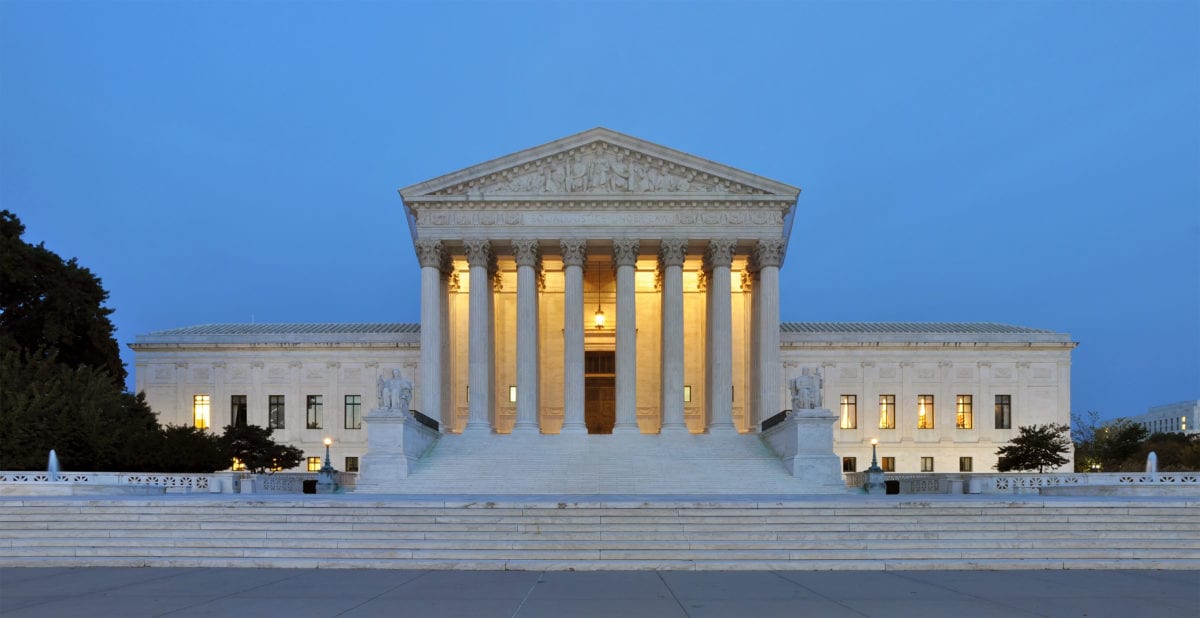“You shoot an arrow into a far-distant future, when you appoint a justice” to the United States Supreme Court.
— President Dwight D. Eisenhower
The Big Picture –
By Glynn Wilson –
WASHINGTON, D.C. — The first of the summer heat and humidity arrived in the nation’s capital this week, and unfortunately, I’m not heading up into the mountains to camp this year. So I’m hunkered down in the air conditioning consuming all the hot news, much of it related to the United States system of justice, which remains under fire on several fronts.
The hottest quote of the week came from former Washington, D.C. Metro Police officer Michael Fanone, who testified in the trial of Daniel Joseph “DJ” Rodriguez, 40, of Fontana, California, who was sentenced by U.S. District Court Judge Amy Berman Jackson to 12 years and seven months in federal prison for conspiracy and obstruction of an official proceeding, obstruction of justice, and assaulting a law enforcement officer with a deadly or dangerous weapon.
Fanone took the stand and called unequivocally for the U.S. Department of Justice to indict former President Donald Trump for inciting the violent insurrection, suspending the peaceful transfer of power and trying to overturn the 2020 election.
“Pursue an indictment against Donald Trump,” Fanone told the roomful of federal prosecutors and spectators. “No one in this country is above the law.”
Related: Trump Supporter Who Tased DC Cop Michael Fanone in Capitol Attack Sentenced to 12 Years
On Jan. 6, 2021, Fanone was one of the metro police officers who responded to the distress call at the Capitol as the Capitol Police force was overwhelmed in the attack by riled up Trump supporters who seemed hell bent on stopping Congress from certifying the outcome of the 2020 election. As he did his part to try to protect the Capitol, members of Congress trapped inside and the Constitution itself, as he was sworn to do, he was knocked down and stuck in the crowd when Rodriguez stuck an electroshock taser to his neck and shocked him twice.
Fanone suffered a traumatic brain injury and a heart attack, losing consciousness for two minutes. He had to be pulled back behind the police line by other officers.
The events of Jan. 6 left him not only damaged but also alienated, he testified. He left the D.C. police force at the end of 2021, saying his colleagues had turned on him for his efforts to hold Trump and Republican leaders accountable for inciting the mob that nearly killed him.
“My career, my friends, and my faith in the criminal justice system I dedicated my life to — extinguished because I did my job and lived to tell about it,” he said in court.
Many cops and members of the military were on Trump’s side even after the attack on the Capitol, including Shane Lamond, 47, of Stafford, Va., who was indicted recently on one count of obstruction of justice and three counts of making false statements to federal law enforcement officials about communications with Enrique Tarrio, the leader of the Proud Boys, after he was charged in 2020.
Related: DC Top Cop Indicted for Obstruction in Colluding With Proud Boys Leader
Meanwhile, there is still no word from the U.S. Department of Justice, Attorney General Merrick Garland or special prosecutor Jack Smith on whether Trump will be indicted for inciting the violent insurrection.
A detailed investigative report out this week confirmed much of what I have been warning about for months, no years. Since being appointed by President Joe Biden, and confirmed by the U.S. Senate, Attorney General Merrick Garland was too afraid of appearing to be politically partisan to do his most important job even by his own admission: “… bringing to justice those responsible for the attack on the U.S. Capitol on Jan. 6, 2021.”
It also shows that FBI director Chris Wray, a Republican Trump appointee, quashed investigations of Trump and his top associates because he wanted to remain on the job as FBI director under President Joe Biden. So much for honorable statements about the independence of the United States Department of Justice. Fear of what Trump’s partisan, political base might think and careerism take precedence over justice in this Justice Department.
Related: Fear and Careerism Rule the U.S. Department of Justice? No Zeal for Justice for Trump?
Over at the Supreme Court, more revelations came out this week showing how big money has corrupted the highest court in the land. It is supposed to be the most independent branch of government, where justices are appointed for life precisely because that is supposed to keep them from bending to political pressures and being corrupted by the ideology of the time. They are paid an annual salary of over a quarter of a million dollars, $274,200, and the Chief Justice gets $286,700 per year. How can that not be enough money to live like kings even in these inflationary times?
But no, we already knew that Clarence Thomas likes to hang around with conservative billionaires and take lavish perks and gifts without reporting them as court ethics guidelines require. We now know that Justice Sam Alito is involved in the same sort of malfeasance.
Who’s shoes will fall off next?
There is a growing chorus to do something about this in the name of “restoring trust in the court.”
A recent poll from Quinnipiac found public approval of the court at an all-time low of just 29 percent.
The same poll found that a majority of 51 percent of Americans agree with prosecuting Trump on criminal charges for his mishandling of classified documents.
Trump Indicted for Mishandling Classified Documents and Conspiracy to Obstruct Justice
Senator Sheldon Whitehouse of Rhode Island has been arguing for years that a flood of “dark money” flowing through right-wing front groups has corrupted the Supreme Court. Never has there been more evidence to bolster his claim, according to a column in The Washington Post.
Others have called for expanding the court to make it more fair by adding more members. Whitehouse does not — for now — want to “get out over our skis” in jumping to court expansion. The country isn’t there yet, in his view.
Sheldon Whitehouse was right all along: The Supreme Court is corrupt
President Joe Biden has also recommended against it.
Lifetime Appointments
According to an analysis by the John Marshall Center on why justices are given lifetime appointments, the American Judiciary’s framework is outlined in Article III of the Constitution.
The power is vested in the executive branch, the president, to appoint justices, while the legislative branch, the Senate, has powers of consent and confirmation.
“He (the president) shall … by and with the Advice and Consent of the Senate, appoint Ambassadors, other public Ministers and Consuls, Judges of the supreme Court, and all other Officers of the United States, whose Appointments are not herein otherwise provided for, and which shall be established by Law …”.
This clause empowers the president to nominate and appoint justices to the Supreme Court but requires Senate confirmation of those nominees. The first nominations for the Supreme Court were issued in 1789 by George Washington, as a result of the passage of the Judiciary Act of 1789.
A justice’s tenure is outlined in Article III, Section I of the Constitution:
“The judges, both of the supreme and inferior courts, shall hold their offices during good behaviour, and shall, at stated times, receive for their services, a compensation, which shall not be diminished during their continuance in office.”
The phrase “during good behavior” has been interpreted to mean that a judge can remain in office for the duration of their lifetime, unless they are removed from office for misconduct, or retire from their post voluntarily. Once a judge has assumed the bench, they may hold that position for the remainder of their lives if they so wish.
“The premise behind instituting lifetime appointments was to reinforce the judiciary’s role as an independent branch of the U.S. Government,” the center says. “In theory, by giving federal judges and Supreme Court justices lifetime tenure that exceeds congressional or presidential term limits, they are insulated from the political pressures the executive and legislative branches could exert.”
Additionally, a judge cannot be recalled simply because their ideology has shifted since their appointment further insulating the judiciary against political reprisals from the other branches of government. Although the theory has been tested, the majority of the Supreme Court’s justices have been perceived as sitting above the party politics that dominate the everyday actions of members of the legislative and executive branches.
One aspect of lifetime appointments that has evolved since the turn of the nineteenth century is the shift in life expectancy. The average American was expected to live until their mid-forties in the year 1800; today’s life expectancies push well into the 70s. That means that a judge appointed to a position at the age of 40, could easily have several decades on the bench before their retirement or death.
Americans have debated whether or not to amend the Constitution to impose term limits for Supreme Court justices for decades. Those who favor such reforms cite concerns about older justices’ advanced age impeding their ability to fully perform their duties and assert that justices who have served for decades are too disconnected from modern societal norms to effectively make decisions that reflect the will of the people.
Those who favor retaining lifetime appointments for federal judges and justices find any criticism of the practice to be fundamentally unconstitutional. They believe that lifetime appointments are intrinsic to the way the judiciary functions and that imposing term limits would fundamentally weaken the Court’s ability to function independently of its sister branches.
The most recent development regarding term limits came in April of this year, when President Joe Biden announced that his administration would launch a bipartisan commission to examine potential reforms to the Supreme Court. In addition to examining options like expanding the Supreme Court, the commission plans to review whether or not term limits for justices should be imposed.
FAQ
Q: IF JUDGES ARE ALLOWED TO HOLD THEIR OFFICES DURING THEIR “GOOD BEHAVIOR,” HAVE THERE EVER BEEN INSTANCES WHERE A JUDGE OR JUSTICE HAS BEEN THREATENED WITH REMOVAL FOR “BAD” BEHAVIOR?
A: Absolutely. In 1804, Associate Justice Samuel Chase faced impeachment by the House of Representatives, a trial spearheaded by Virginia Representative John Randolph and backed by none other than President Thomas Jefferson. Chase, a staunch Federalist with a powerful personality, was a frequent target of Jefferson’s ire, especially after Republicans gained control of Congress in 1801.
Hoping to make an example of Chase, Randolph and other Republican House members claimed he had “behaved in an arbitrary, oppressive, and unjust way” and claimed that he refused to dismiss biased jurors in trials. The House voted to impeach him in March of 1804, but when the Senate took up their trial in February of 1805, their votes on each article of impeachment failed to reach the two-thirds minimum required for conviction. Chase was acquitted, and the trial effectively created a precedent restricting future instances of executive or legislative interference in judicial practices.
More generally, only 15 judges have ever been impeached by the House of Representatives for misconduct, and, of those, only eight have been convicted and removed from office.
Q: WHO IS THE OLDEST SUPREME COURT, AND WHO WAS THE OLDEST PERSON EVER TO SERVE ON THE COURT? WHICH JUSTICE SERVED THE LONGEST TERM?
A: Justice Stephen Breyer, 82, was the oldest justice serving on the Court until he stepped down and retired and President Joe Biden appointed Judge Ketanji Brown Jackson to the high court.
Related: Justice Jackson’s Confirmation to the Supreme Court is a Major Turn in the Arc of History
Breyer would have had to serve eight additional years to break the record for the oldest sitting justice, set by Justice Oliver Wendell Holmes, Jr., who was 90 when he retired in 1932.
The longest serving justice on the Supreme Court was Justice William O. Douglas, who served for more than 36 years. But the longest serving Chief Justice was none other than Chief justice John Marshall, who served for 34 years.
Q: ARE ALL JUDGES IN THE UNITED STATES ABLE TO SERVE FOR THEIR ENTIRE LIFETIME?
A: No. In lower courts, there are often term limits for judges, and the process by which a judge takes the bench is different than at the Federal level. While Federal judges and Justices are appointed by the president, judges of lower courts are often elected by the general public, and their terms range from four to 18 years, depending on the state in which they serve.
Many states elect judges, which makes it hard to argue that the judiciary is above politics.
Even the current Chief Justice, John Roberts, has called for term limits.
“The Framers adopted life tenure at a time when people simply did not live as long as they do now. A judge insulated from the normal currents of life for twenty-five or thirty years was a rarity then, but is becoming commonplace today,” Roberts said before he was appointed to the court. “Setting a term of, say, fifteen years would ensure that federal judges would not lose all touch with reality through decades of ivory tower existence. It would also provide a more regular and greater degree of turnover among the judges. Both developments would, in my view, be healthy ones.”
Lifelong appointments for justices are resulting in increasingly longer terms, according to the Center for American Progress, with significant implications for the politicization of the court. Creating term limits for justices would establish regularity in vacancies and help to avoid an escalation of the negative outcomes linked to justices’ ever-longer lifetime tenures.
“The nine individuals who sit on the Supreme Court hold incredible power over American life,” they say. “It is therefore vital that the makeup of that court not be determined by happenstance but rather by Americans’ support for those policymakers tasked with selecting and confirming federal judges.”














